Have you ever noticed how quiet a closet wall is compared to other interior walls? Stand inside a walk-in closet, and noise is almost nonexistent. The same factors that make a closet quieter are also what makes denim insulation soundproofing a good choice.
Is denim insulation good for soundproofing? Denim insulation is an eco-friendly non-carcinogenic recycled material. It has a multi-dimensional microstructure that isolates and traps sound waves to control noise. With an STC of 52 and an NRC of 1.15, it can provide superior sound suppression in Renos or new builds.
In this article, we’ll explain what denim insulation is and how it works to improve sound control. We’ll look at how to install it for sound suppression. Explore the pros and cons and how it compares to fiberglass insulation. Plus, take a look at several of the denim insulation products on the market. When you’re finished, you’ll have a better understanding of how denim insulation works and why it is an excellent option for your soundproofing projects.

What is Denim Insulation?
Denim insulation was developed in the early 1980s. It is manufactured from denim and cotton post-consumer recycled products that retailers, second-hand stores, and people no longer want. It also includes cut-offs and castoffs from mills and manufacturers, plus industrial cotton scraps. The insulation includes post-industrial cotton and denim, including blue jeans.
Insulation made from blue jeans and cotton is collected from a variety of sources. The zippers, buttons, bling, and other things that aren’t cotton are removed. The material then goes through large shredders that reduce it to small pieces. It then goes through another processor that separates the material into fibers.
The resulting blue cotton candy looking material is blended with 15% to 20% new fiber. The mixture is then treated with boric acid to make it resistant to flame, rodents, insects, fungi, and mildew. The final process involves heating the cotton fluff and pressing it into rolls of set thicknesses for packaging and shipping.
Denim Insulation Pros and Cons
Denim insulation has been available since the early 1980s. It is a GREEN eco-friendly, non- carcinogenic alternative for thermal and sound control applications. Denim is low density and decreases thermal conductivity, so less movement of heat or cold. That means it is good for home and sound insulation and why it is LEED-certified.
Denim has a multi-dimensional micro-structure. It controls sound by isolating and trapping sound waves. The insulation is 80 to 85% recycled content. It can even be recycled after a lifetime insulating a structure, keeping cotton waste out of landfills forever. It is also environmentally safe and uses less energy to produce than most other insulations too. Batts are compression fit and available in R-13, R-19, R21, and R-30.
Pros
- Acoustic ratings are 10 to 30% better than fiberglass
- Slightly better R-ratings than fiberglass
- No VOC off-gassing or formaldehyde
- Doesn’t cause skin irritation or itching
- Improved air quality and fewer triggers for asthma or allergies
- Resists mildew, fungi, bacteria, and mold
- Lower energy consumption
- Class A fire rating
Cons
- Expensive and not available everywhere
- Very heavy if it gets wet
- Takes longer to rebound from packaging compression
- May need to be trimmed to standard framing cavities
Denim Insulation Soundproofing Properties
The porous, multi-dimensional natural fibers of blue jeans insulation make for excellent sound absorbency. The porosity and density of the insulation, coupled with the fiber shape, contribute to denim’s superior STC rating of 52, and NRC value of 1.15. There is more surface area within the material to interrupt and transform sound energy into heat.
Denim sound insulation cuts sound transmission through walls, floors, and ceilings. It can also be used in acoustic traps, panels, and to wrap plumbing, duct, and HVAC pipes. The cotton material is easy to work with, has no VOC off-gassing, or irritating carcinogenic filaments.
Is Denim Insulation Good for Soundproofing?
Insulation made from blue jeans and other cotton products is good for soundproofing. The fibers are multi-dimensional, porous, and dense. The manufacturing process also ensures there are voids within the compressed panels. The fiber and insulation structure work together to improve soundproofing.
Soundwave frequencies penetrate the insulation and bounce off the different facets of the fiber, or are caught in the pores. Those that are deflected get trapped in voids or pores, which convert the frequency energy into heat. The heat quietly dissipates. Denim insulation has an NRC average of 1.15 and an STC value of 52, making it ideal for soundproofing applications.
How to Install Denim Insulation
Denim insulation soundproofing installs the same way stone wool and fiberglass insulation do, through compression fit. The cotton insulation comes in compressed rolls or batts. The compressed material needs time to rebound to its original thickness. It’s best just to remove the insulation from the packaging and give it a shake. It should then sit for a bit to reach its full loft. It will take longer at higher humidity.
The rolls of insulation are perforated, so they separate into standard 48” tall framing widths. They friction fit into 16” and 24” on-center wall, ceiling, or floor cavities. For weird-shaped spaces or cavities, the perforations may work, or cut the cotton mat with a utility knife. If a vapor barrier is required, a semi-impermeable plastic sheet is recommended by the manufacturer.
Denim vs Fiberglass Insulation for Sound Absorption
Sound absorption is influenced by many factors including, density, porosity, and thickness. Wall construction and workmanship are also essential considerations when soundproofing. Using batt insulation, rigid panel, or blown-in will also influence absorption. The insulation can be used in walls, ceilings or floors, or in acoustic traps to control sound.
Higher density materials usually have more fibers, so they will have more area to interfere with and absorb sound waves. A higher density is also important in controlling low-frequency soundwaves. The greater the density, coupled with higher porosity, usually means more sound absorption.
The porosity refers to the voids within a material. Greater porosity means insulation will be able to trap more sound. The trapped sound energy is converted to heat energy, which then silently disperses.
Fiberglass insulation is manufactured from synthetic fiber with a uniform, smooth cylindrical shape. Blue jeans insulation (cotton) is a natural fiber with a porous multi-dimensional profile so that it will absorb more sound.
The thickness of insulation often influences the frequency range that material will interrupt. However, greater thickness doesn’t mean a proportional increase in sound absorbency. It should be noted, though, that thicker multi-dimensional fibers will absorb more low-frequency noise.
| Denim vs. Fiberglass Insulation for Sound Absorption | |||
| Comparisons | Denim | Fiberglass | |
| NRC | 3-1/2” thick | 1.15 | 0.90 to 0.95 |
| 6” thick | 1.15 | 1.05 | |
| STC | 3-1/2” thick | 52 | 46 |
| 6” thick | 53 | 49 | |
| Thermal Rating | 3-1/2” thick | R-13 | R-10.9 |
| 6” thick | R-21 | R-18.8 | |
| Density | 3 lbs and 6 lbs/cubic foot | 1.5 lbs and 3 lbs/cubic foot | |
| Fire Rating | Class A | Class A | |
Recommended Products
Several different companies manufacture denim insulation. It is a renewable, natural material with excellent properties for controlling sound transmission. UltraTouch™ denim insulation by Bonded Logic is the result of 35 years of industry expertise. Frost King has been manufacturing and supplying solutions to keep the weather out for almost 100 years. Here’s a product from each:
UltraTouch Denim Insulation
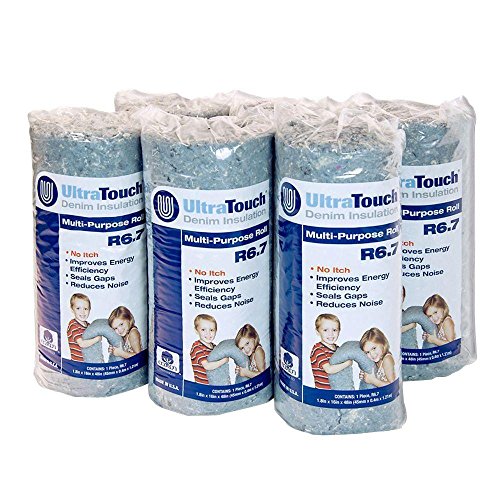 Ultratouch™ denim insulation is made of denim and cotton material. It is 80% post-consumer material, and 20% pre-consumer cut-offs, making it 100% recycled content. The insulation is available in widths of 15”, 16.25”, 23”, and 24.25” to compression fit between the studs. Battens come in both 48” and 96” lengths. The thicknesses and thermal rates are 2” = R-8, 3.5” = R-13, 5.5” = R-19 or R-21, and 8” = R-30.
Ultratouch™ denim insulation is made of denim and cotton material. It is 80% post-consumer material, and 20% pre-consumer cut-offs, making it 100% recycled content. The insulation is available in widths of 15”, 16.25”, 23”, and 24.25” to compression fit between the studs. Battens come in both 48” and 96” lengths. The thicknesses and thermal rates are 2” = R-8, 3.5” = R-13, 5.5” = R-19 or R-21, and 8” = R-30.
The batts are perforated but can be cut or pulled apart to fit as required. The cotton is treated with boric acid and is fire, mold, mildew, rodent, and insect resistant. The eco-friendly insulation doesn’t off-gas or have airborne particles to irritate the eyes and skin. The UltraTouch™ manufacturing process creates a three-dimensional product that isolates, traps, and controls sound frequency waves.
The cotton insulation can be used in wall, ceiling, and floor cavities to stop sound transfer. It will minimize echo, vibration, and flanking through ductwork and pipes. The denim insulation can also be used inside automobile panels to control noise or acoustic panels in homes or businesses. The versatile product has both thermal and acoustic benefits.
Frost King CF1 “No Itch” Multi-Purpose Insulation
 Frost King’s multi-purpose 1” thick cotton fabric insulation has a thermal rating of R-4 rating. It is made of 100% recycled content. The material is treated with boric acid to make it fire, insect, rodent, mold, and mildew resistant. It can be cut or torn to fit where needed.
Frost King’s multi-purpose 1” thick cotton fabric insulation has a thermal rating of R-4 rating. It is made of 100% recycled content. The material is treated with boric acid to make it fire, insect, rodent, mold, and mildew resistant. It can be cut or torn to fit where needed.
The insulation is sustainable, has no VOC off-gassing, and is child and pet-friendly. There are no irritating or carcinogenic fibers floating around either. Goggles, a mask, and gloves aren’t required, but safety is a good practice. The recycled denim damps noise, reduces vibration, cushions, and insulates.
The 1”x16”x48” sheets will fit between studs to absorb soundwaves. It can be used inside ducts or wrapped around ducts to mute echo and noise transfer. The recycled jeans insulation will work inside acoustic panels, bass traps, and conditioners to improve sound control too. It is also safe for use to insulate or cushion pet houses, boxes, or cages.
Conclusion
Using denim insulation soundproofing is an environmentally friendly alternative to fiberglass. The multi-dimensional structure of cotton, porosity, and denser material deliver better NRC and STC values. It also provides higher thermal ratings too. The natural material improves sound control and provides health benefits synthetic insulations don’t.
Hopefully, you have a better understanding of denim insulation – what it is, how it works, and why it’s a viable alternative for your soundproofing projects. If you found this article interesting and helpful, pass it on to someone who may also benefit. Your comments and suggestions are always appreciated.
You May Also Like:
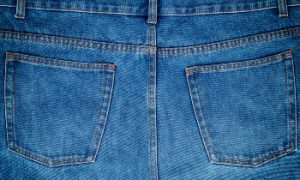
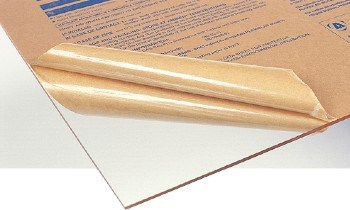
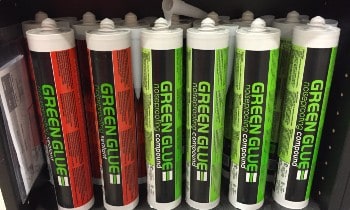
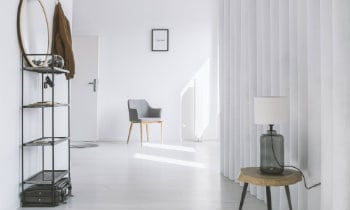

Since 3-1/2″ denim and 6″ denim has the same sound absorption rating why use 6″ denim material. What the rating of 3″ or 2″ denim material?
Hello!
Your chart that compares denim to fiberglass compares 3.5″ and 6″ thick materials. Frost King’s denim comes in 1″ thickness. Does that mean you would have to triple the product to get the desired soundproofing? Are all denim insulations 1″ thick?
Hi Eugene, Thanks for providing great info. I am seeking the best sound acoustic and thermal properties. Was going use polyiso on ceiling then 1/4″ cedar planks as finish but thinking not the best for sound as I will have high end audio system with mega bass. I have good sound deadener up and on walls and doors. So 1st what do you think of the cedar idea. Was planning on having 1/2″ gap between them with black matte surface behind them which could be possible be rigid foam insulation. I have ideas how to secure the cedar also the planks extremely lightweight. Would 1/2-3/4′ gap have any bearing with sound. Aside from polyiso, XPS or EPS foam board, using wool like rockboard 60 or 80 or similar by Roxul or Owen Corning some having black surface (or foil backed I could paint black) that can be left open to interior. The frostking or ultratouch denim in 1″ could be used on ceiling too being my main concern. Walls mostly covered with bed and cabinets leaving 3 big rear windows and and 6 door windows that will get sound curtains or plugs. So what might you advise for the ceiling Thanks
Paul
Very useful info! Thank you
Thank you for providing this information! My contractor suggested using denim, but I was leary until I read your information. I appreciate you posting this for us.
How do you cut it into accurate shapes? I have used an electric carving knife on thick foam with good results, and there are hot knife products, but not sure about denim.
Hi Tim,
The easiest way is with a Magnum Shut N Cut. Carving knife will probably work. I would use a Sawzall with a fairly fine toothed blade. Or a fine toothed jig saw.
Terry